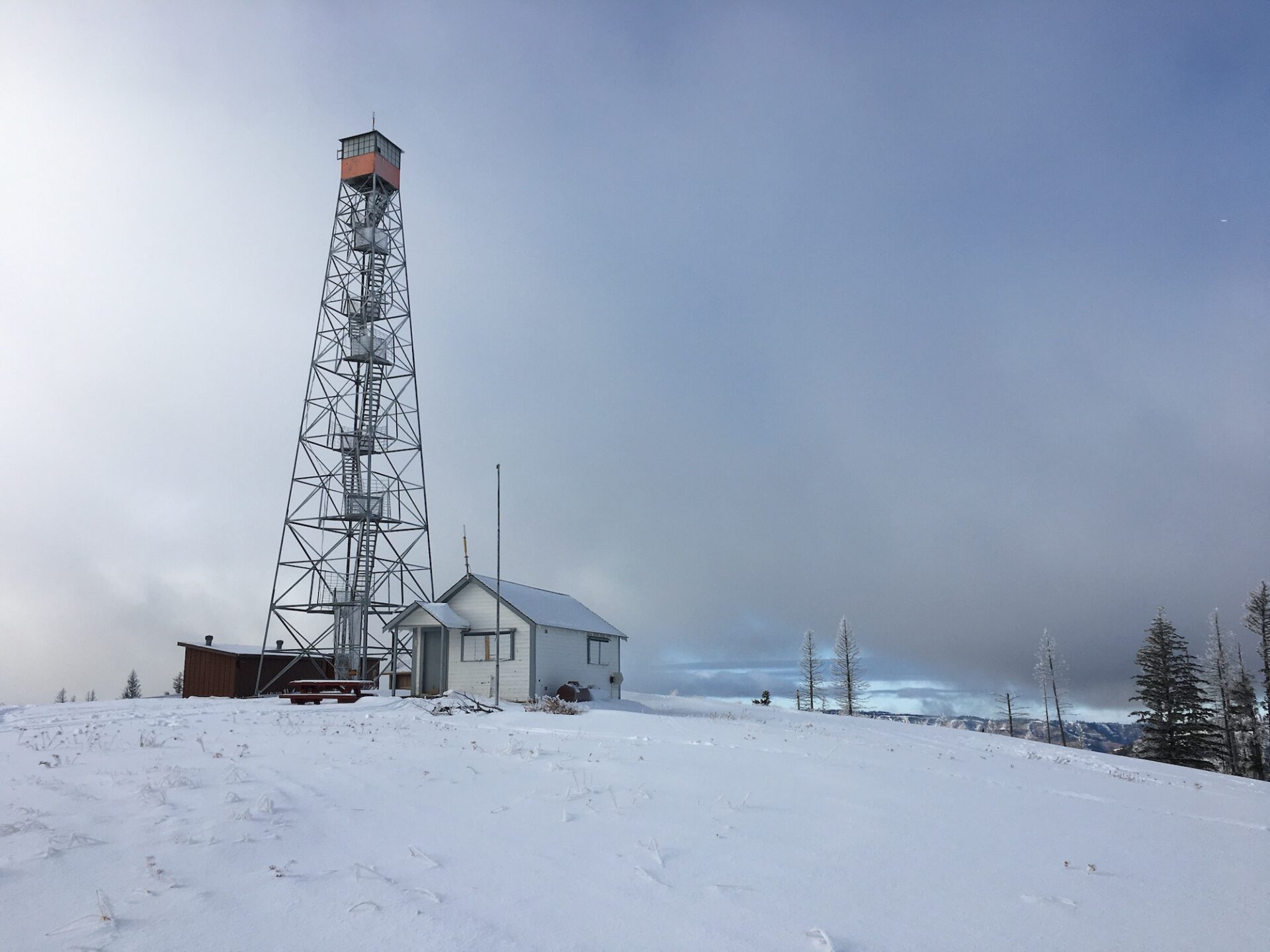While most people were busy with family obligations for Christmas, I packed up my Altai Hok skis and my newest partner in crime, my recently adopted cattle dog Hudson, and together we enjoyed an unplugged, off-the-grid 5-day backcountry ski retreat amongst the beautiful backdrop of Washington’s Blue Mountains. We saw more moose than people, found our very first wolf tracks, and said goodbye to 2019 surrounded by wildlife, solitude, and beauty. It was the perfect kind of quiet reflective holiday time I enjoy.
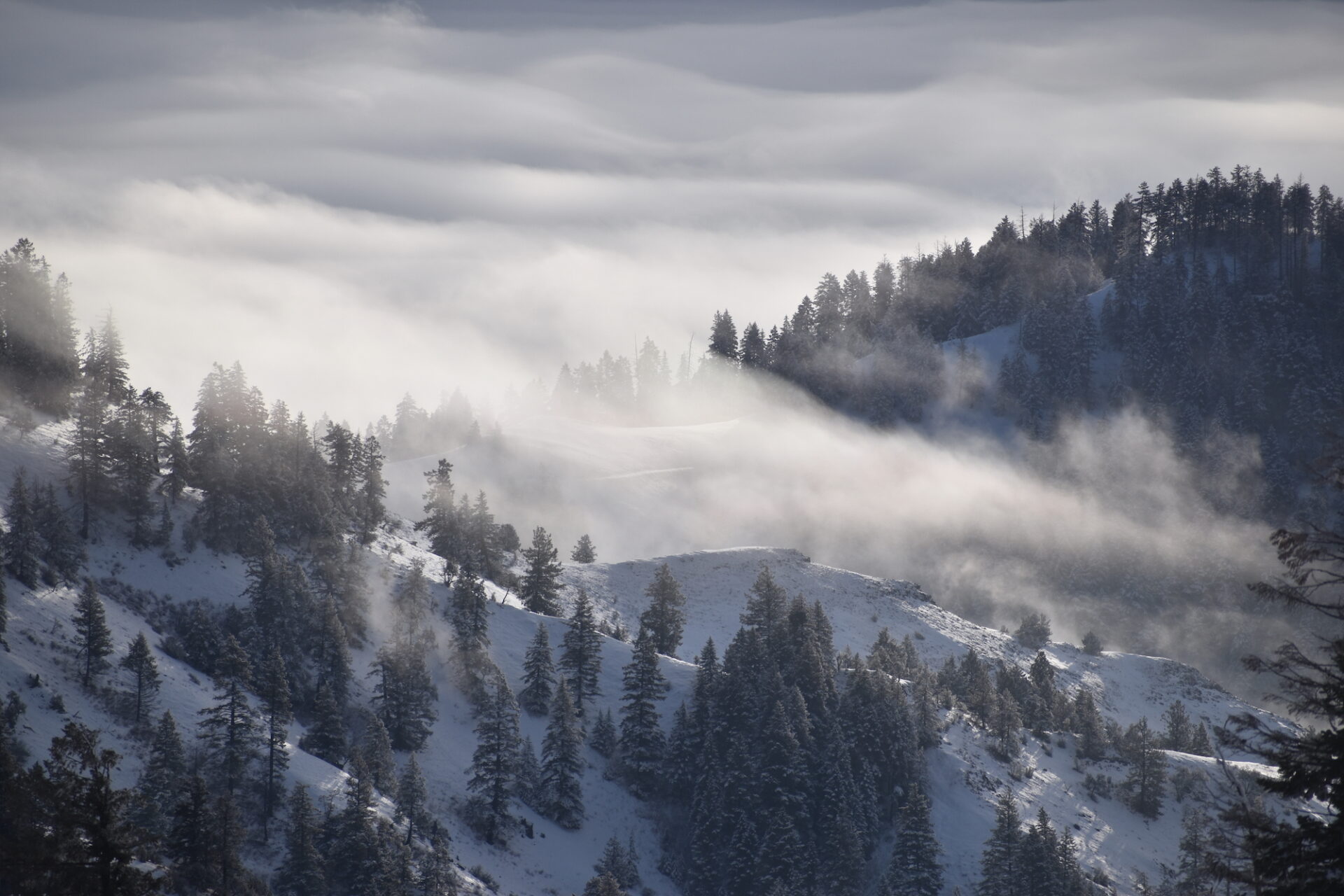
But before I jump ahead, if you’ve never heard of Altai Hok skis, you’re probably asking yourself, “What in the heck is hok skiing?”
Altai Hok skis, made local in Curlew, Washington, are often called skishoes and their name and design is inspired by the skis used by the native Tuwa people in the Altai Mountains of Asia. The Hok’s short length, wide size, and integrated skins make them highly versatile for exploring all kinds of terrain in all kinds of conditions. Their small size and light weight also makes them extremely packable.
After snowboarding, splitboarding, and cross country skiing for many years, I bought a pair of Hoks and I love them so much that the rest of my gear is now collecting dust. What I love the most is being able to explore without being relegated to groomers. The Hoks are perfect for that and despite my limited downhill ski skills, I can go everywhere with these skis and now all I do is hok because it’s so much fun!!!
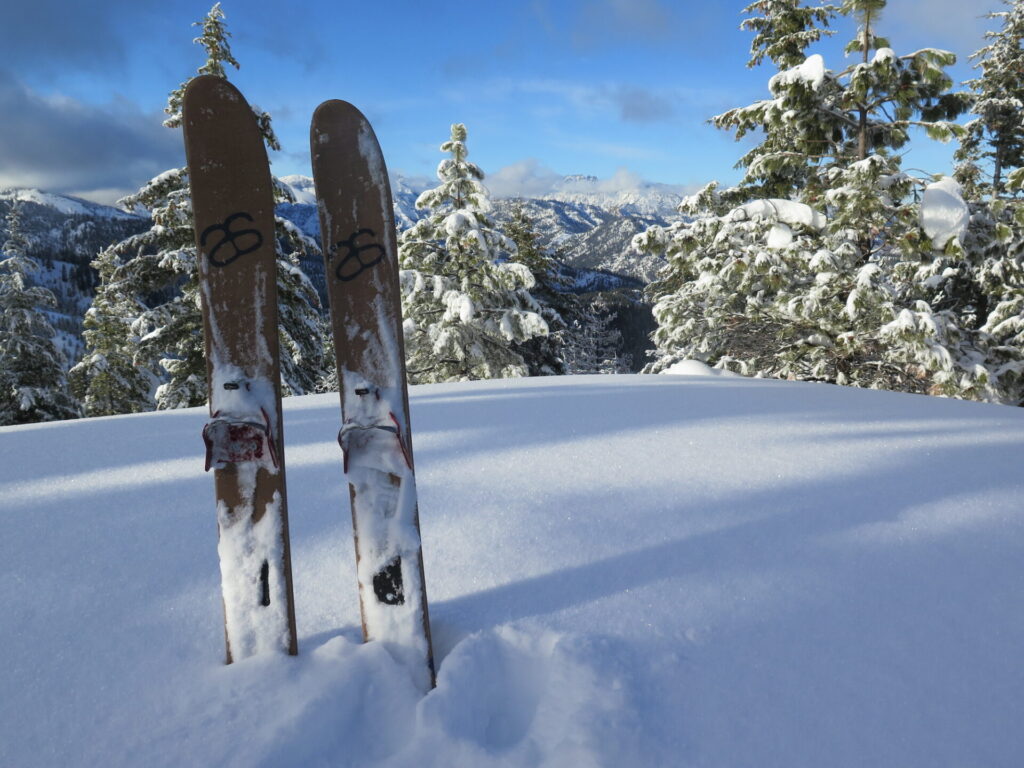
I’ve enjoyed finding new places to “hok” and when I first visited the magical Blue Mountains of southeast Washington on a fire lookout trip back in July 2018, I knew they’d make a superb ski touring destination.
The Blue Mountains, commonly called the Blues, stretch into Oregon and contain the 1.4 million acre Umatilla National Forest as well as the Wenaha-Tucannon Wilderness. The range is filled with open ridges, big mesas, and dramatic sheer-walled canyons that provide a home for moose, elk, wolves, bear, and bighorn as well as an astounding array of year-round recreational opportunities. Sno-Parks and groomed main roads allow winter access to the entirety of the wilderness and the Blues even have several year-round dog-friendly rentals, most of which are old forest service guard stations.
Planning a 5-day ski trip to the Blues.
Back in December, our infuriatingly fickle snowpack was rearing its ugly head and conditions were abysmal across the state. SNOTEL sites at 5,000′ in the Blues were reporting only 4-6″ of snow, which was thin, but better than most places and barely enough for cross country skiing. I waited until two days before Christmas to finally plan a tardy holiday getaway and was quite surprised when rentals in the Blues had last-minute availability. In fact, they seem to rarely be fully booked in winter, which is even more surprising!
Having been up to the Clearwater fire lookout back in July of 2018, I thought it would be fun to stay at the ground cabin at the base of the 94′ steel lookout tower, so I booked two nights there and another two nights at the historic Wenatchee Guard Station on the eastern side of the Blues. Both structures are above 5,000′ and were built in the 1930s by the Civilian Conservation Corps.
Reaching both rentals requires snowshoeing, skiing, or snowmobiling—the Clearwater Lookout a 6.5 mile journey from the Rose Spring Sno-Park south of Pomeroy and the Wenatchee Guard Station a 3.5 mile journey from the Cloverland Sno-Park outside Asotin. During heavy snow conditions the trip may be further if you’re unable to reach the Sno-Park.
Only 13 miles separate Clearwater and the Wenatchee Guard Station, so I briefly considered skiing between them. Ultimately I decided it was a little ambitious for my first multi-day Hok tour and I much preferred the idea of carrying two days of supplies versus five. I settled on driving the 75 miles back out to Pomeroy and around to Cloverland, a further venture than usual in winter due to road closures.
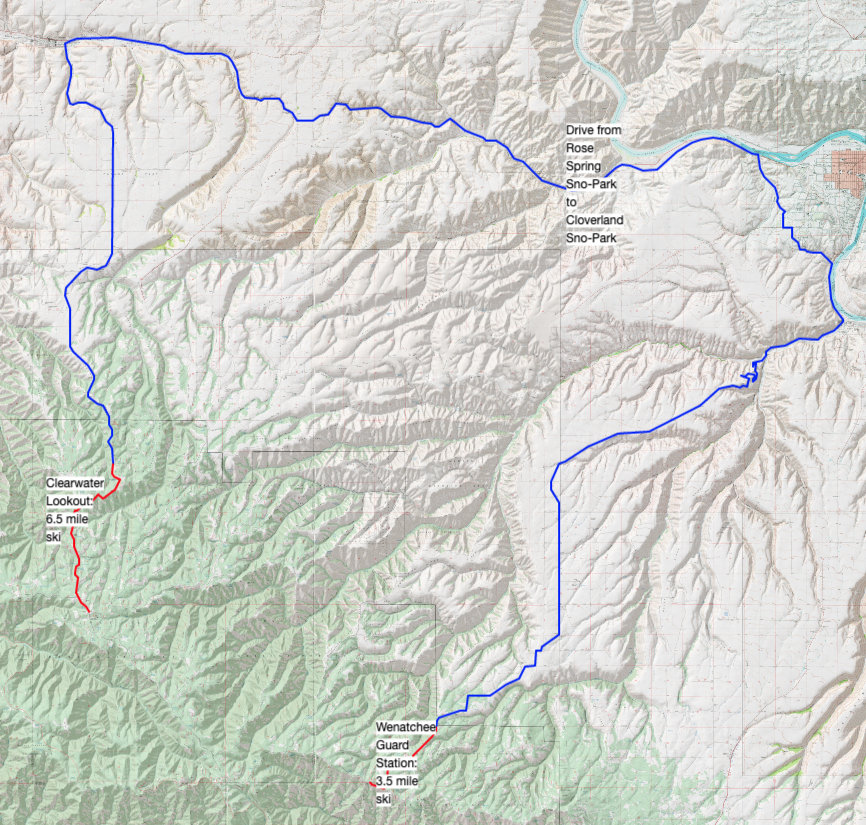
To break up the 5+ hour drive and ensure an early start during short winter days, I made an overnight stop at Palouse Falls State Park. From there, the Rose Spring Sno-Park would be a quick hour drive and hopefully get me on my way to Clearwater Lookout at a reasonable time the next morning.
Palouse Falls State Park.
Palouse Falls State Park is a 94 acre state park created in 1951, named for the beautiful 200 foot Palouse Falls that cascades from the Palouse River. It makes a great stopover on the way to the Blues since it’s a short detour from the town of Washtucna along the way.

A huge bonus of traveling on Christmas Day is the lack of traffic and crowds. The four hour drive to Palouse Falls zipped by quickly and when I pulled into the parking lot around 3pm it was completely deserted, the only time in multiple visits I’d ever had it all to myself! If you ever want solitude at Palouse Falls, I’d highly recommend making a trip on Christmas Day.
The park has 11 campsites, all first-come, first-served and very communal, so Hudson and I had zero complaints that we had no other neighbors. In fact, the next person we’d see would be the Park Ranger the next morning. For nearly 20 hours all we heard were the distant sounds of coyotes, the falls, and a few passing trains. I couldn’t believe our luck.
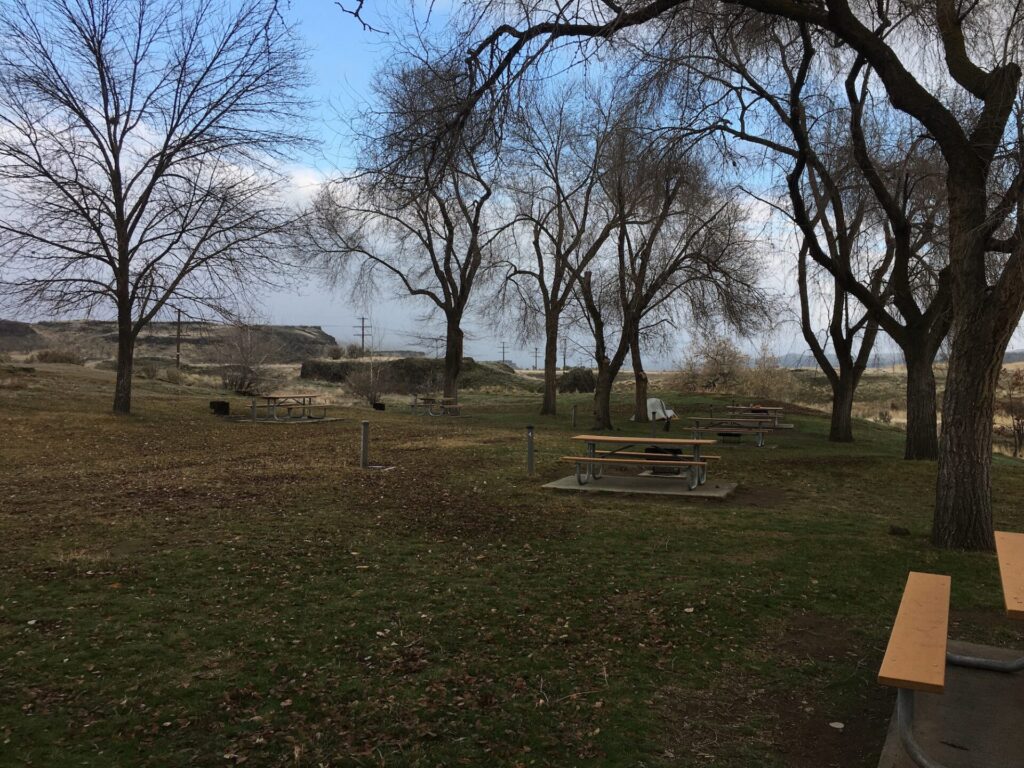
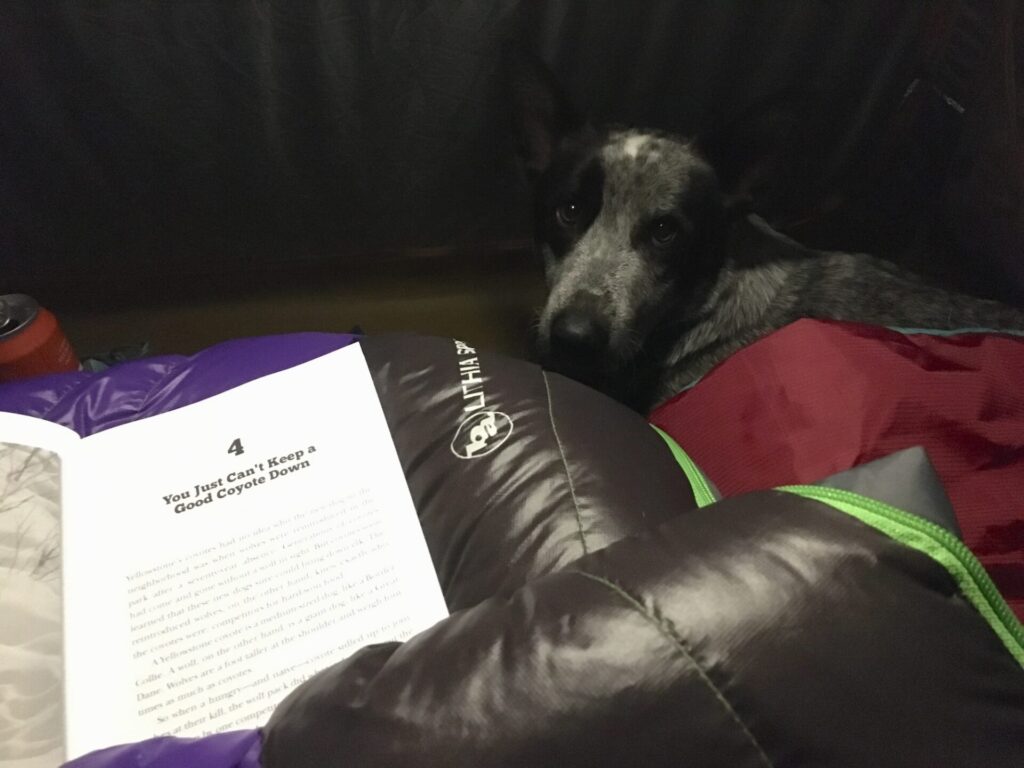
The next morning we awoke to dense freezing fog, very common for eastern Washington in winter. I was so mesmerized watching Palouse Falls slowly materialize out of the fog that I had no problem delaying our departure to enjoy the show and let the roads de-ice.
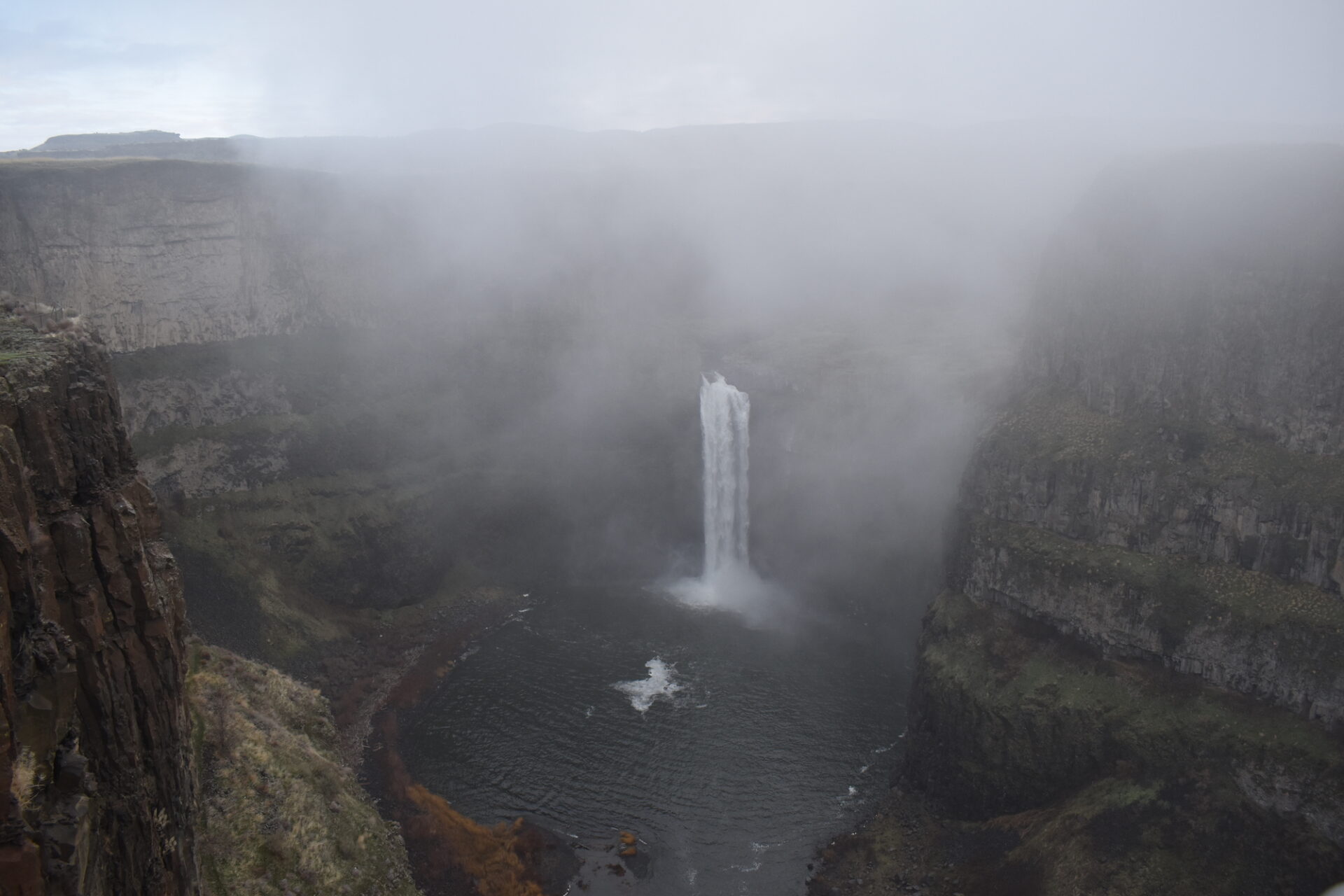
Blues skies and big game.
Once on the road, I stopped by the Ranger Station in Pomeroy to get the combination codes for both cabins. The woman on staff had received no reports on snow conditions because thin snowpack was keeping snowmobiles grounded. She told me I’d likely have the area to myself as a result and I was perfectly fine with that.
Most of my 30-40 minute drive to Rose Spring from Pomeroy was in thick, freezing fog until about a mile before the Sno-Park when the fog parted and revealed glorious blue skies and sunshine. Yes! Even better? Yet again, there wasn’t a single other car around.
Unsure of conditions, I was even more excited to see a freshly groomed road with thin, but adequate snow for my Hoks. The groomers had done a fantastic job with a very thin snowpack and Hudson and I grabbed our packs for our first ski tour together. In a half mile the thin spots disappeared and conditions greatly improved. I know I said I’m not a fan of groomers but the fresh groom was so smooth and fast I was practically skipping along on my skies. In no time I was in a tee shirt, soaking up all the warm sunshine. Simply glorious!
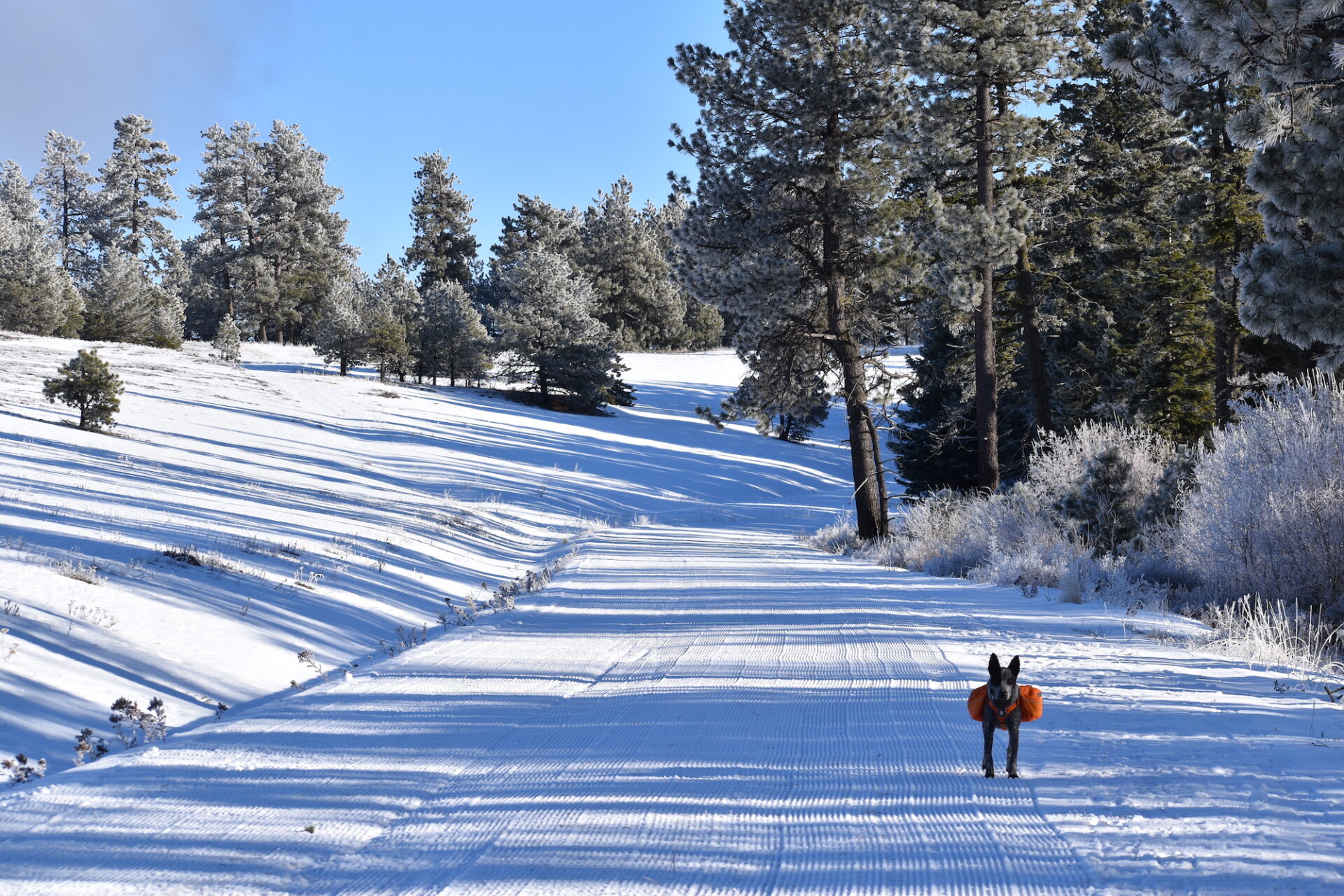
About two miles up the road I saw huge tracks crossing into the groom from the surrounding forest. I’ve learned a lot in my tracking classes and the size of these tracks as well as their wing-like toes meant only one thing: wolf! I had found my very first set of wolf tracks and it was so exciting!
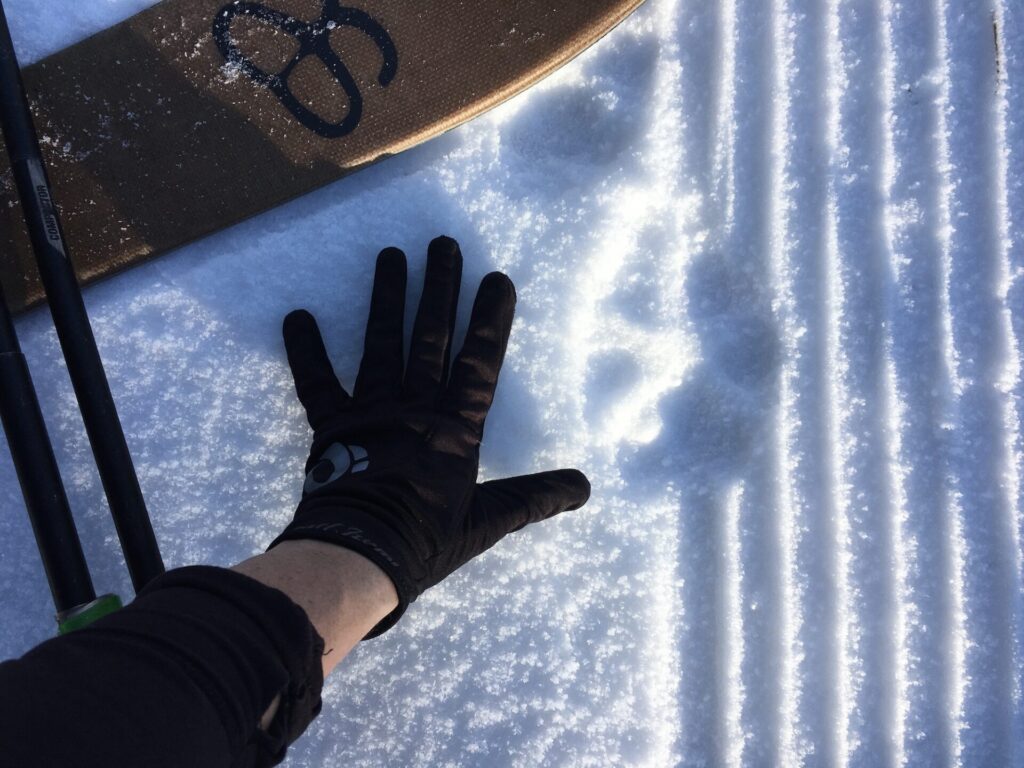
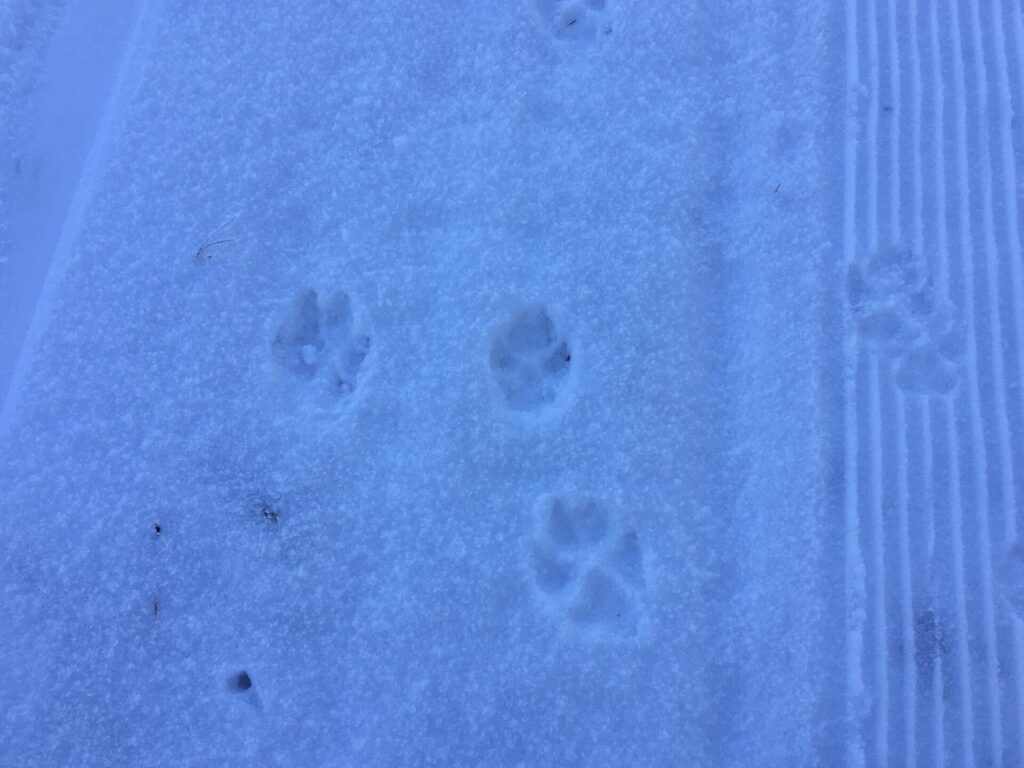
I spent some time geeking out over the tracks and when I trailed them a bit, it became clear there was more than one animal. So very cool! I knew we needed to keep moving to reach the cabin by sunset, which was an early 4pm, so we finally turned away from the tracks and headed back up the road. Over the next few miles the wolf tracks occasionally reappeared and followed the road before turning back into the woods. The wolves were obviously enjoying the freshly groomed road about as much as we were.
Arriving at the Clearwater Lookout cabin.
The Clearwater Lookout cabin sits at an elevation of 5,600′ and was built by the Civilian Conservation Corps in 1935. The 94′ steel lookout tower, constructed in 1933, is no longer open to the public, but the views from the base of the lookout are still impressive.
The entire ski to Clearwater was straight-forward, following the main road and climbing steadily but not steeply with a few small descents along the way. Most of the views were peeks through the forest until the last steady one mile climb revealed not only the lookout in the distance, but also a wonderful backdrop of mountains to the west.
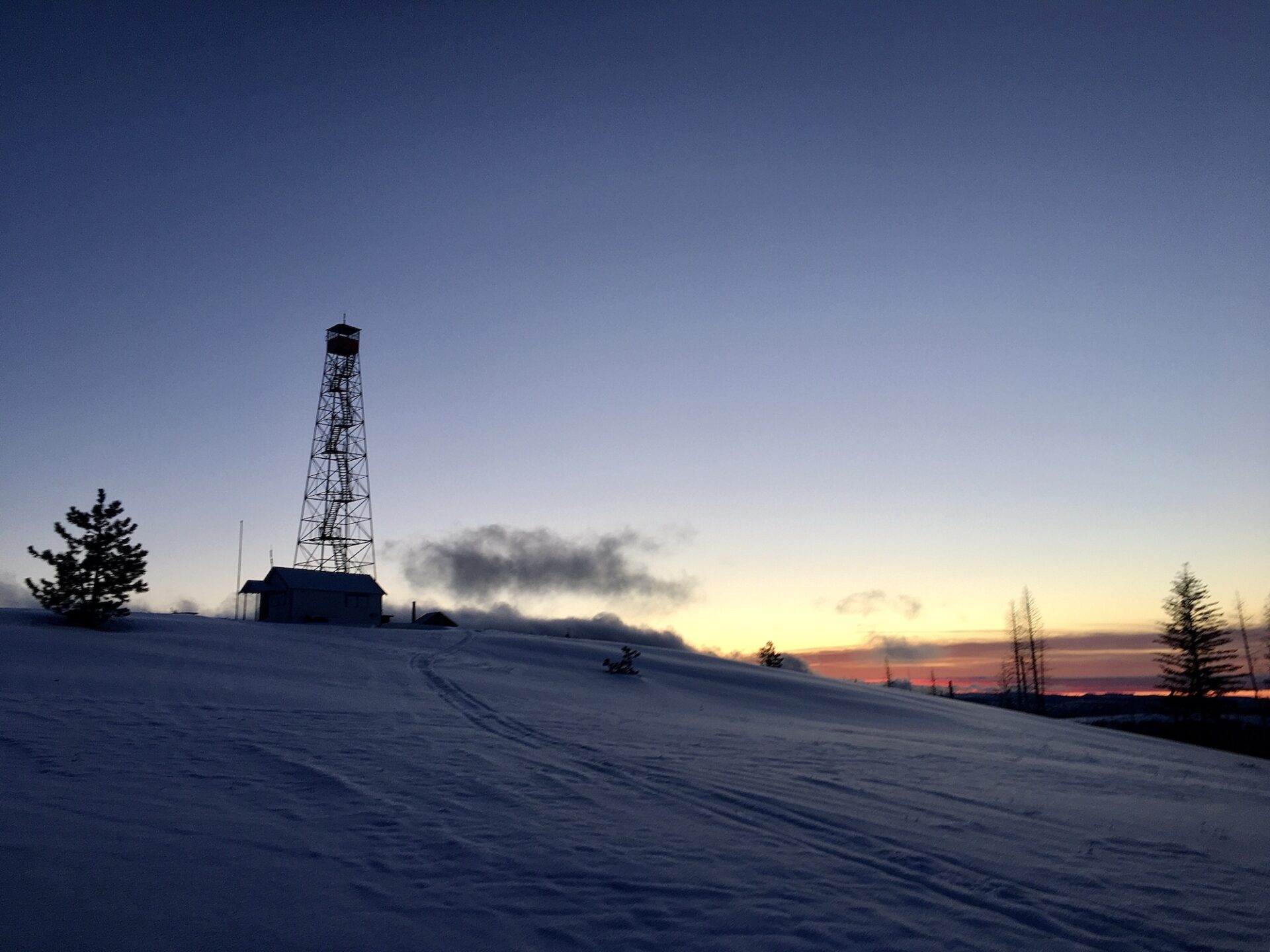
About a half mile from the cabin, any icy wind blasted over the ridge. With the sun dipping low on the horizon, temperatures went from tee shirt comfortable to freezing in a matter of seconds. I stopped to pull out an extra layer and suddenly Hudson, who rarely makes a sound, was alarm yipping and barking and making a huge fuss. I looked up, half expecting to see a wolf. Instead, 30-40 yards away stood a moose and her calf. I had noticed tracks on the road a few minutes earlier and almost couldn’t believe our luck!

I managed to get one photograph of the moose before they continued over the ridge and I was nearly frozen solid by the time I finally pulled on my puffy. We reached the lookout cabin right as the sun disappeared below the horizon. It took my bumbling frozen fingers several minutes to get the persnickety lock on the cabin door unlocked and when Hudson and I finally stepped in, I was convinced the cabin was colder inside than outside.
I pulled out my sleeping bag for Hudson and he wasted no time getting cozy inside it. I spent the next 30 minutes reading through the cabin manual and fumbling around with still frozen fingers to light the propane furnace. Between the cabin manual and a set of instructions written by visitors, it was fairly confusing. When the pilot light finally sparked, I’ve never been happier!
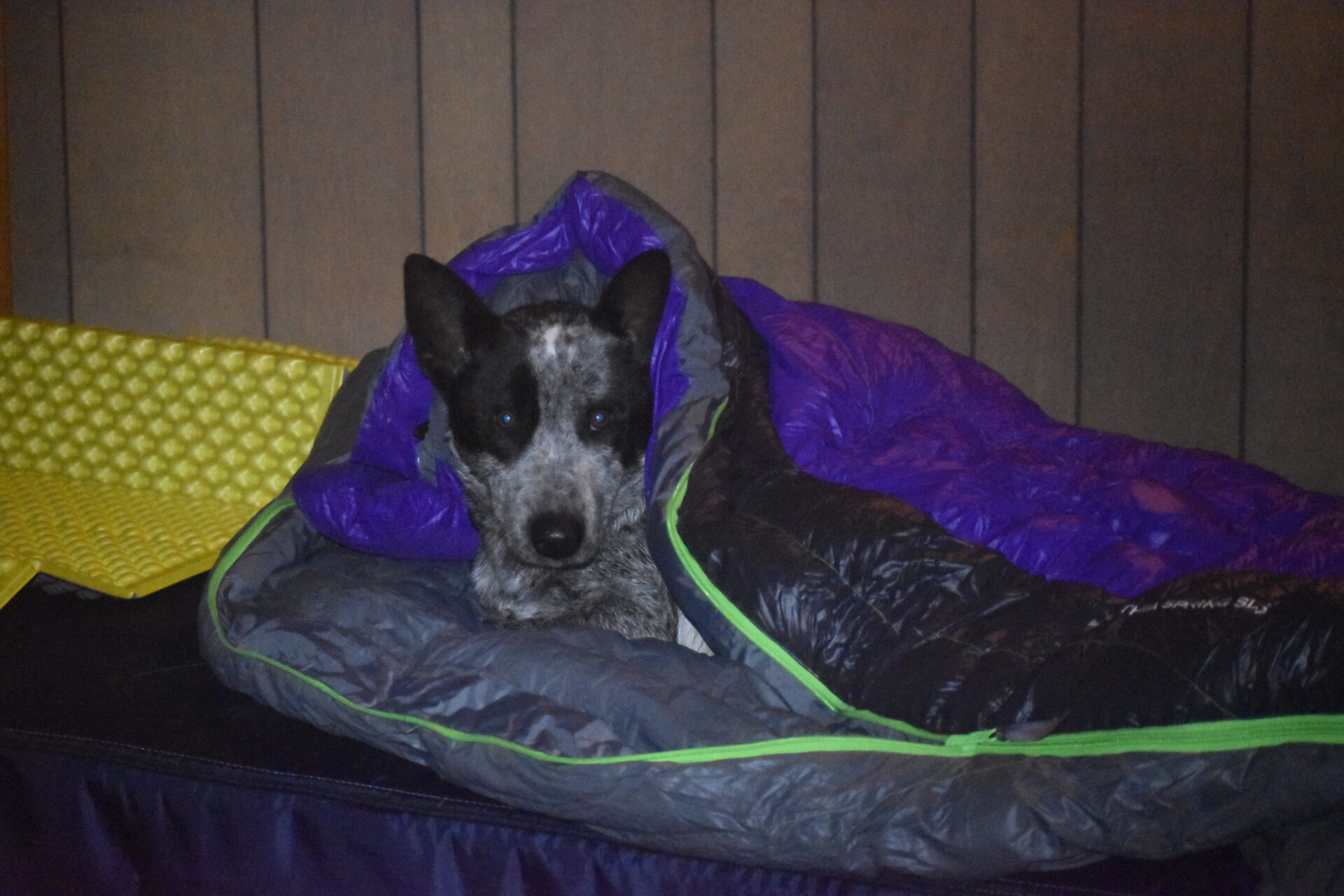
The Clearwater lookout cabin is nicely equipped, with 4 beds and a huge propane tank powering a cookstove, oven, refrigerator, furnace, and lights. The cabin was stocked with cleaning supplies, some paper products, and tons of cookware.
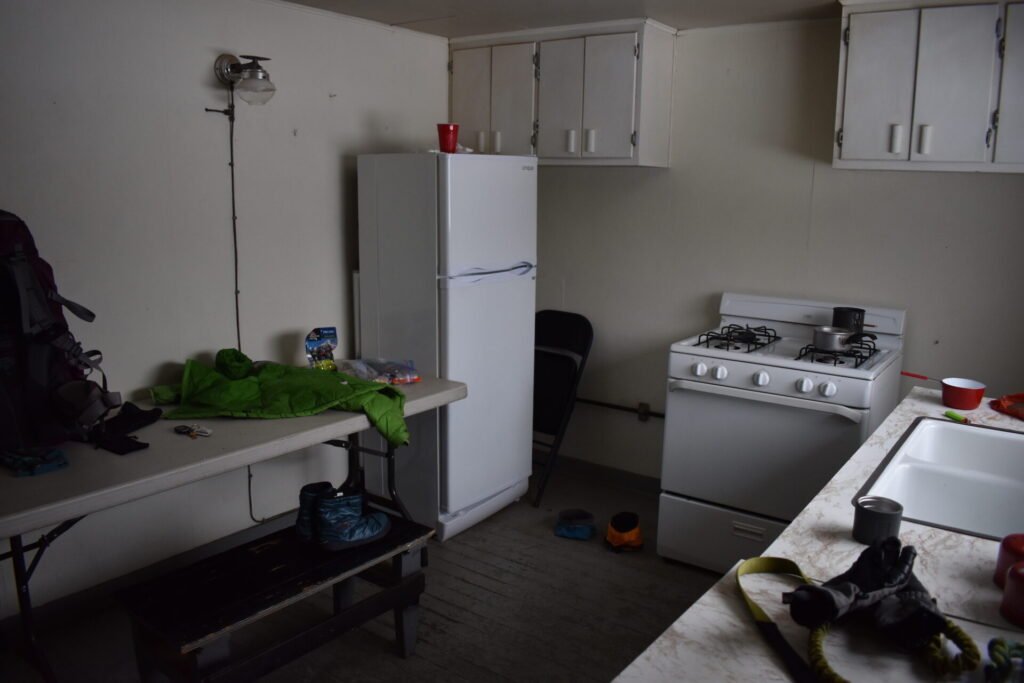
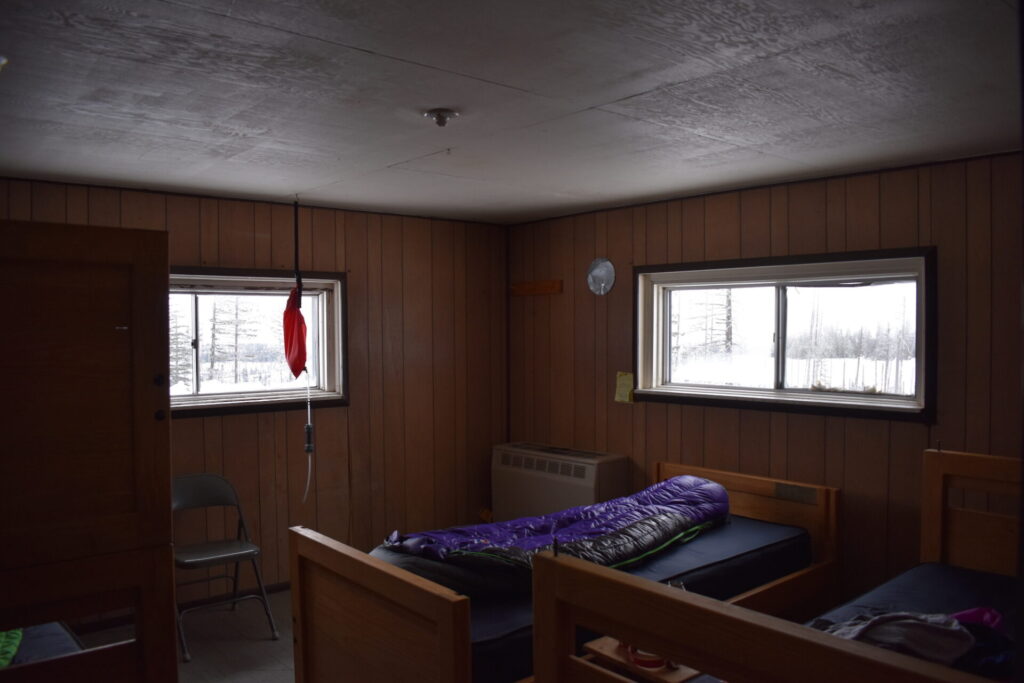
After opening the shutters and settling in, I scooped a bucket of snow from outside to melt water, cooked up a hot dinner and tea, and pretty soon Hudson and I were enjoying our accommodations in cozy warmth.
After dinner I made a trip to the outhouse and discovered my next challenge: 3″ of solid ice accumulated on the ground outside the door, making it impossible to open. I found no shovels on the property and while looking around for some kind of tool to break the ice, I looked down and realized my feet just might be the tool I needed. Turns out that the duck bill on telemark boots doubles as a wonderful ice scraper! Who knew? After banging away for a good 10-15 minutes, I was able to break up most of the ice and open the bathroom door. Survival skills for the win!
That night the skies were clear and stars were bright but the wind, which was frequently gusting up to 30mph, drove temps into the single digits and kept my stargazing sessions short. A few times overnight I had to run outside to secure the shutters from rattling and each time, I made sure to look up for a few moments and enjoy the stars before running back to the warmth of the cabin.
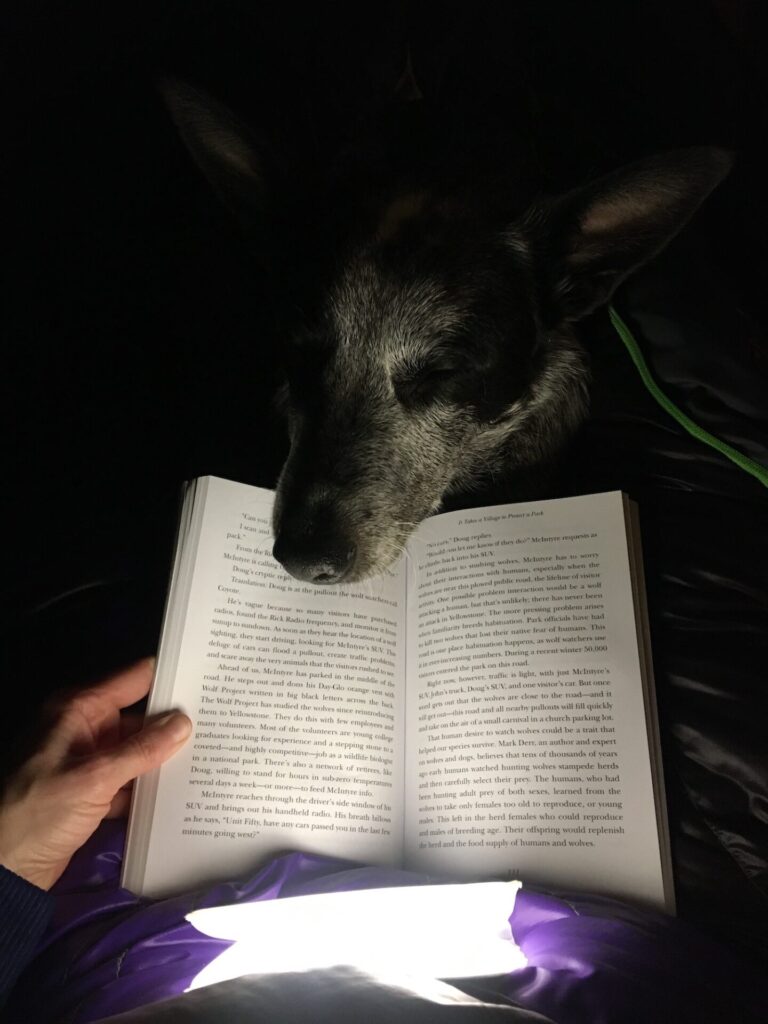
When the universe gifts you champagne.
I hoped to wake up to blue skies the next morning but alas, a freezing fog enveloped the entire area and visibility was zero. Not one to ever be stopped by nature, I grabbed my skis anyway and headed out, keeping our exploring close to the lookout until visibility began to improve.
Though I had to be vigilant for rocks and thin coverage, the snow was the kind you dream about! Light, dry, and perfect champagne. Untouched miles of it were all for us! We skied into the trees and up to ridges, skied roads and trails, and skied turns on every little downhill we could find. My cheeks literally hurt by the end of the day from smiling so much!
By the time we returned to the cabin at sunset we had managed to track out the entire surrounding couple mile radius and somehow logged 14 miles without seeing a single other soul. Hudson earned a huge gold star for his first big ski day as well as a hearty dinner and extra treats. We were both so whooped we both might have been fast asleep by 7:30.
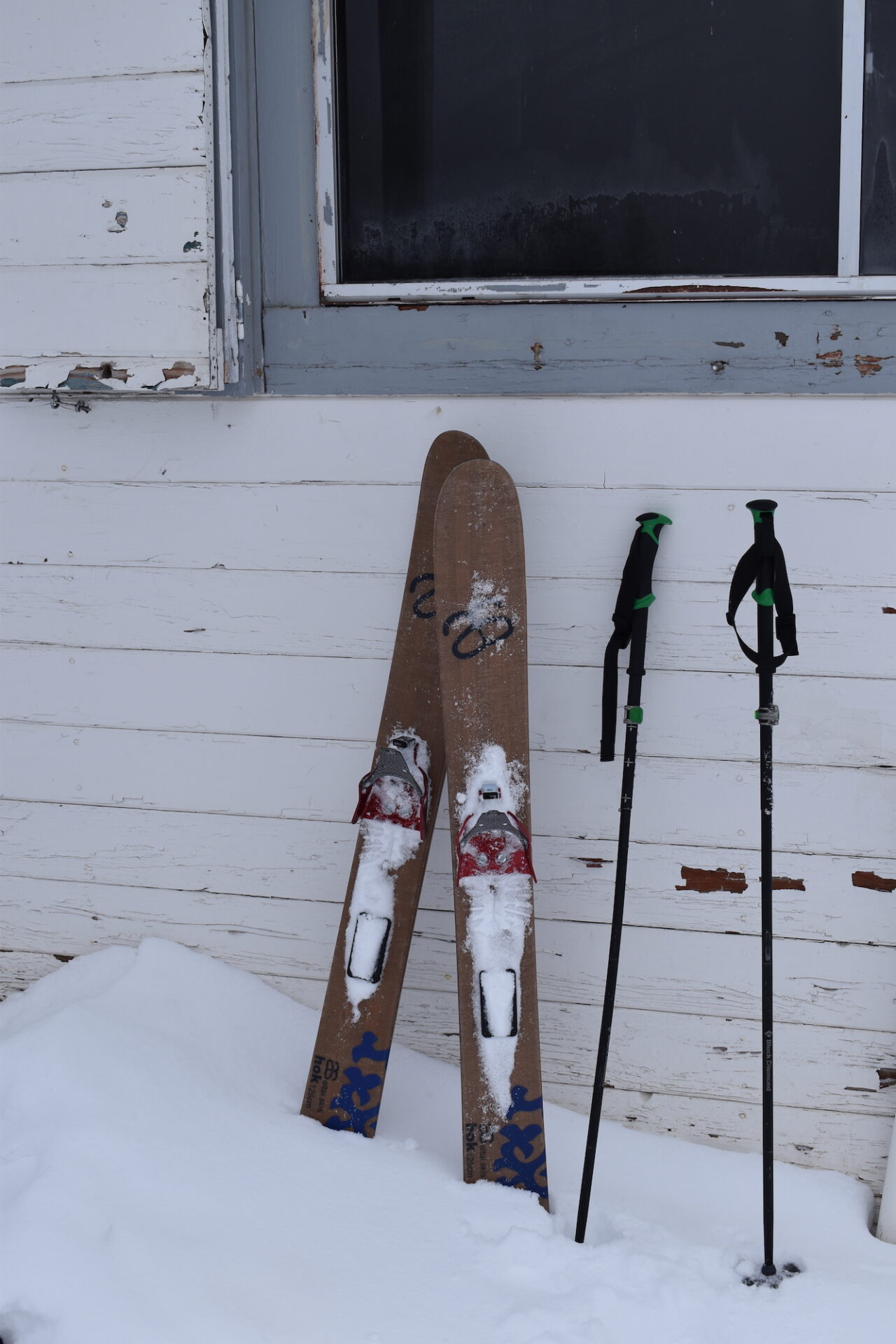
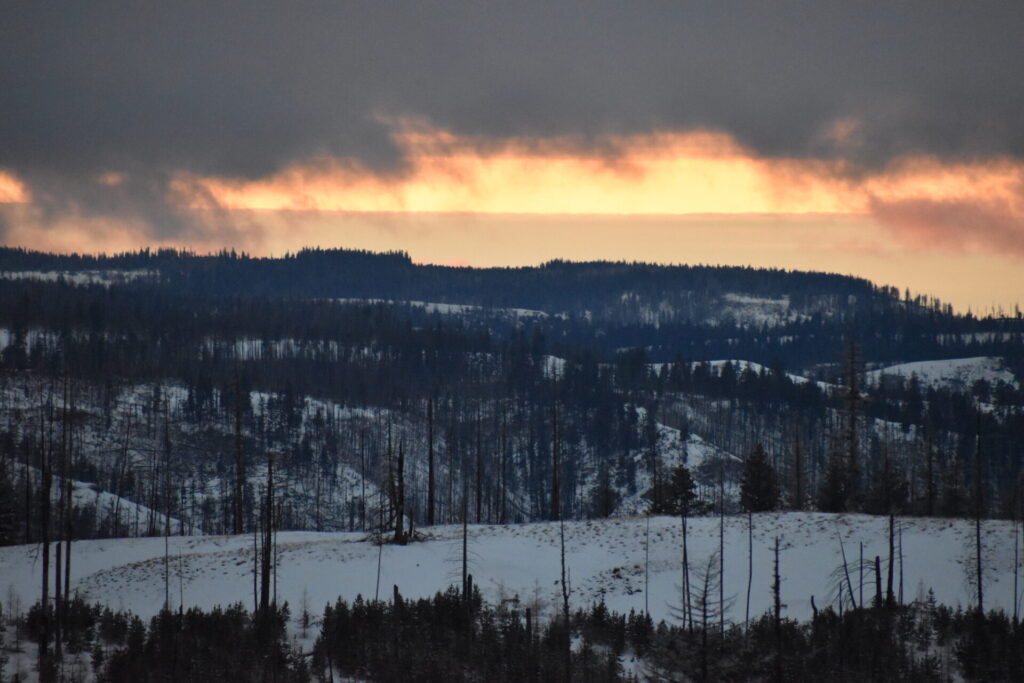
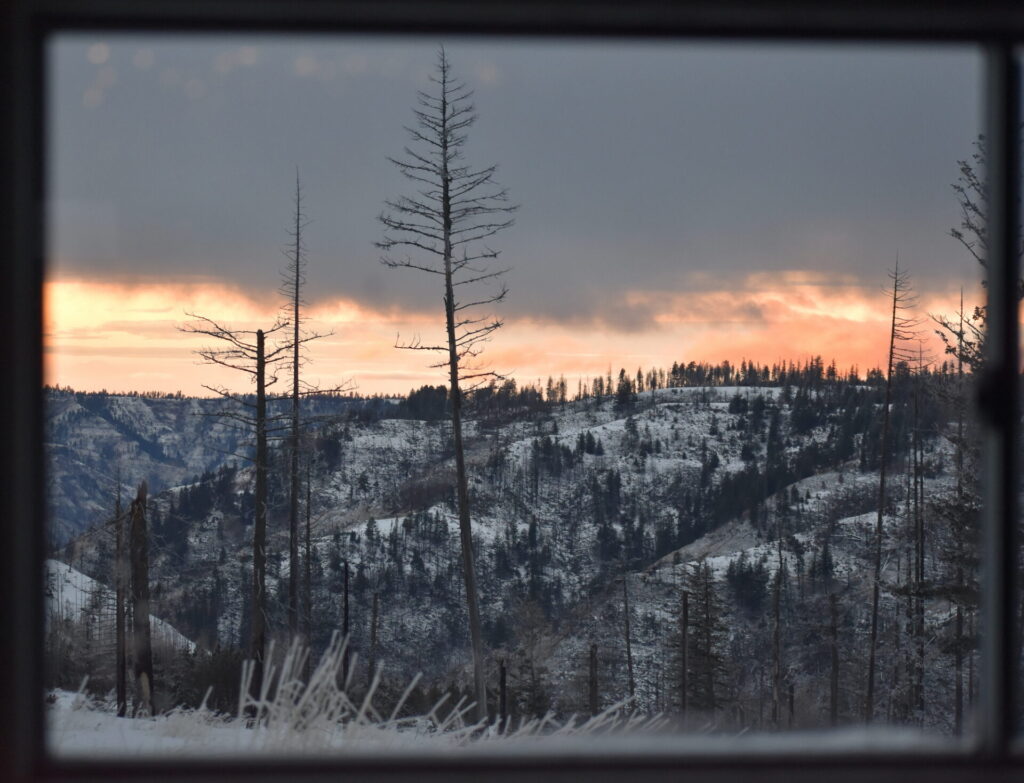
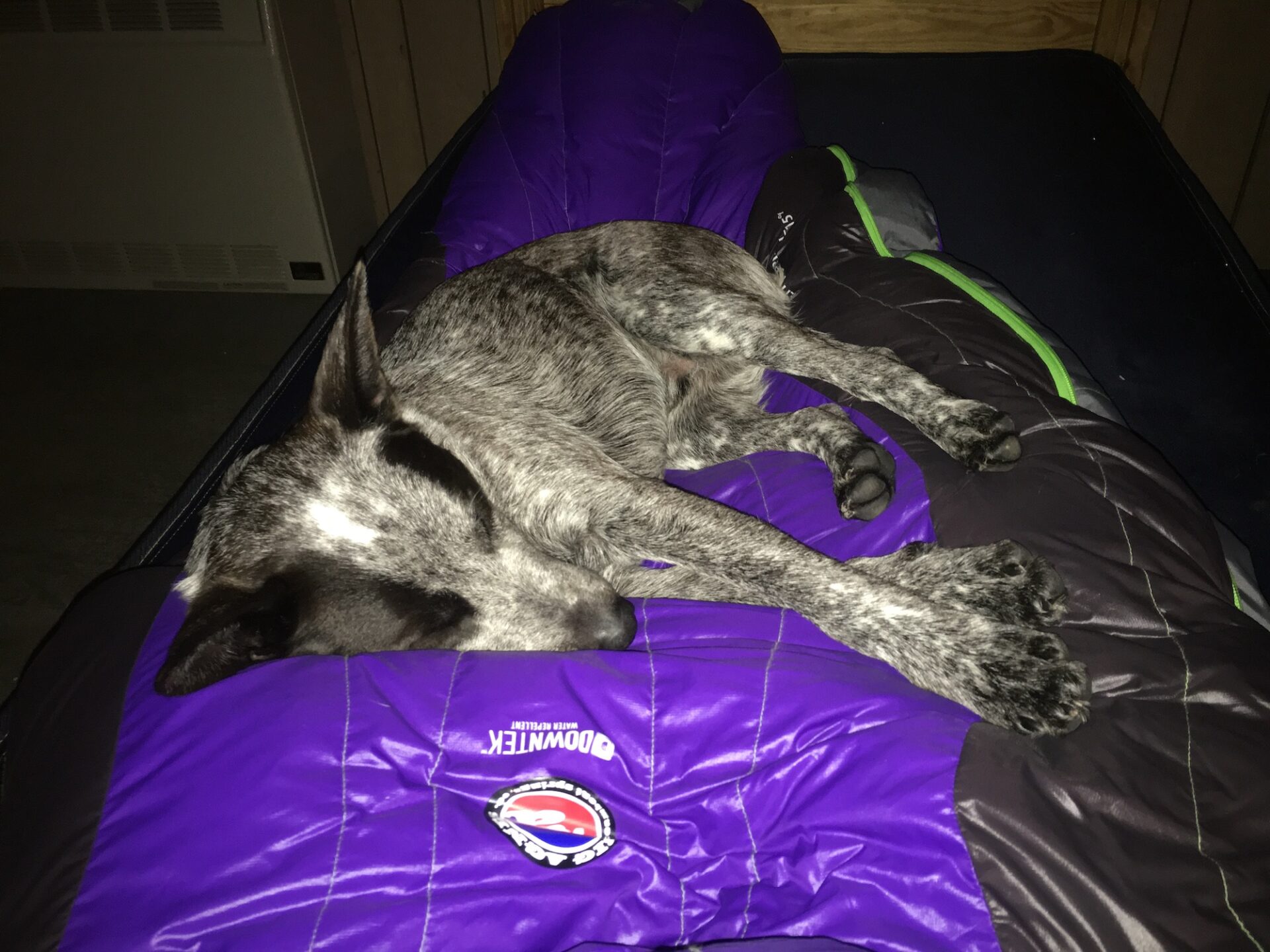
Skiing back to reality.
The next morning broke to perfectly sunny skies and I really didn’t want to leave! Two evenings at Clearwater had gone by much too fast and I easily could have stayed a week. There was an incredible amount of terrain up here to explore. Unfortunately I had to get an early start since I needed to ski out, drive 2 hours over to Cloverland Sno-Park, then ski another 3.5 miles to the Wenatchee Guard Station. Sometimes I wonder what I’m thinking when I come up with logistics like this, but hey, at least it would be a sunny day!
The ski out was beautiful but took a bit longer than expected, mostly thanks to my tired legs and softening, slower snow conditions. The journey back to the Sno-Park also required a mile long ski up “The Big Hill”, a steep incline near Huckleberry Butte. The descent on the way to the lookout sure didn’t seem as big as the climb back, that’s for sure.
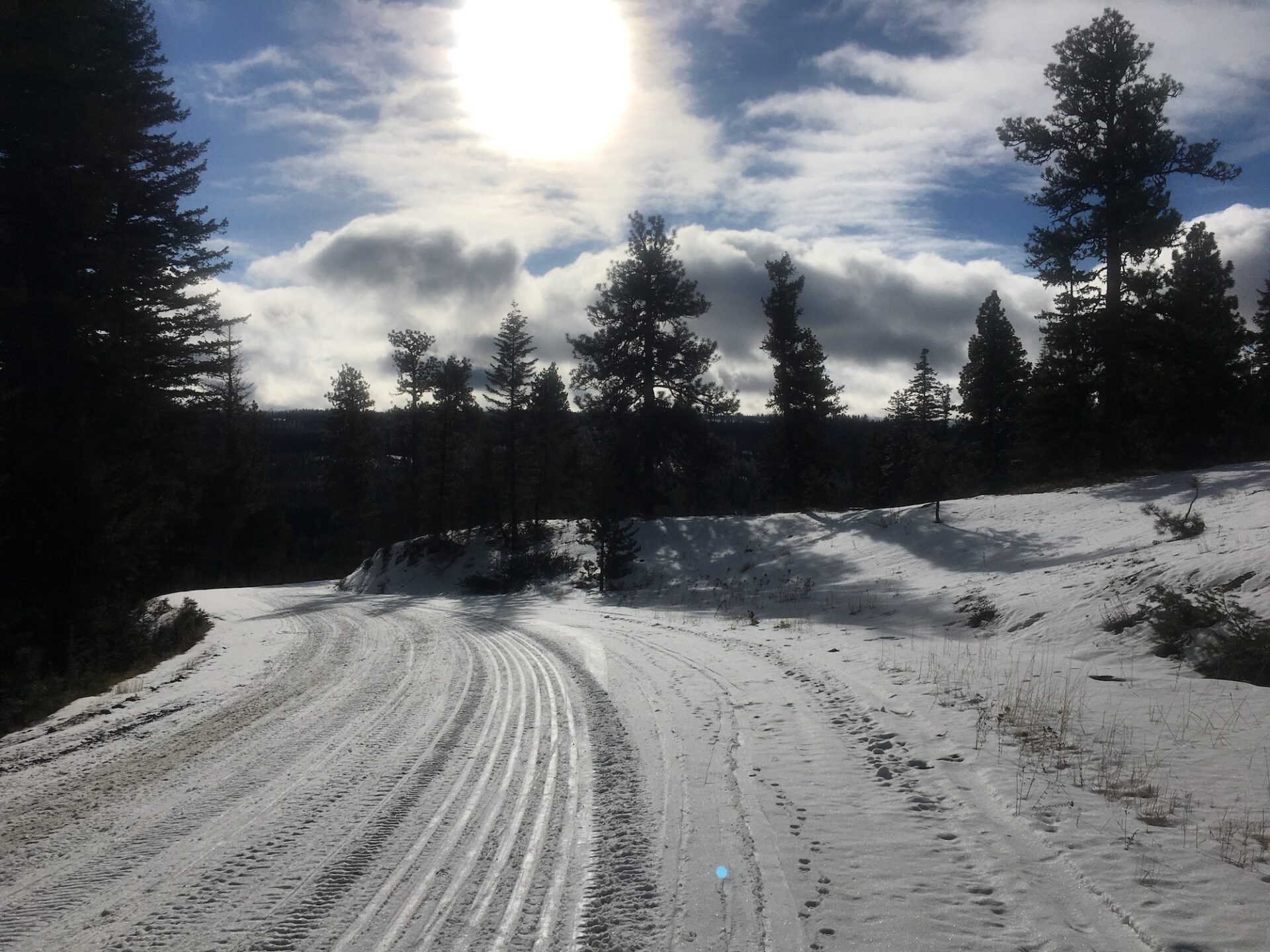
By the time I was within a mile of the Sno-Park, the sun had melted so much snow from the road that I had to take my skis off completely and walk. The bonus of Hoks? They’re incredibly light and easy to carry!
Arriving back at the Sno-Park was a bit of a shock after the previous two days of solitude and silence. When we left it was an island of desolation. On this sunny Saturday of a holiday weekend it was overflowing with people tubing, sledding, snowmobiling, and playing. It took me a few minutes to readjust to the change.
Everyone was friendly and came over to chat, curious about conditions up higher and where I had skied, then two local officers from the Washington Department of Fish and Wildlife (WDFW) showed up. Since I do volunteer work with Conservation Northwest, who often work with WDFW, I struck up a conversation with them about the wolf tracks and moose I saw.
The officers confirmed that indeed, the tracks were wolf and big ones at that, but they were far more interested in my moose sighting. Turns out the Blue Mountains have few moose, perhaps only a dozen, so my sighting was quite rare and lucky. Then the officers jokingly asked why, with all of Conservation Northwest’s remote cameras, we hadn’t yet camera trapped a Bigfoot? It was hilarious and of course anyone who knows me knows I can’t resist a good chat about Bigfoot, so by the time we wrapped up our discussion it was well after noon.
I told the officers I was heading over to Cloverland to ski out to the Wenatchee Guard Station for two nights and I’m pretty sure they thought I was crazy. Indeed, my timeline wasn’t exactly syncing up the way I had planned and since I obviously have no self-control in champagne powder, I had somehow already logged 27 miles of skiing in barely 48 hours!? My legs were feeling more than a little shot.
I knew at this point there was no chance I was making it to the Wenatchee Guard Station without some nighttime ops. Usually I don’t mind skiing by headlamp, but my risk tolerance is conservative when I’m on solo adventures, especially winter ones. I was having a hard time convincing myself that skiing in the dark in single digit temps with only a sliver of a moon and likely no one around but big game was a good idea.
Instead, I stopped in Lewiston, Idaho, across the river from Asotin, and enjoyed a nice dinner and some views of the gorgeous Snake River. I made the decision to get up early and ski in to the Wenatchee Guard Station at first light. Though it would shorten my stay by a night, I preferred the idea of a leisurely morning ski by daylight than one at night.
I pulled into the Hell’s Gate State Park just south of Lewiston to find a camping spot, expecting the park to be busy on such a beautiful Saturday. Would you believe that I pulled in and the only other party there was the camp hosts? Luck was shining on me indeed.
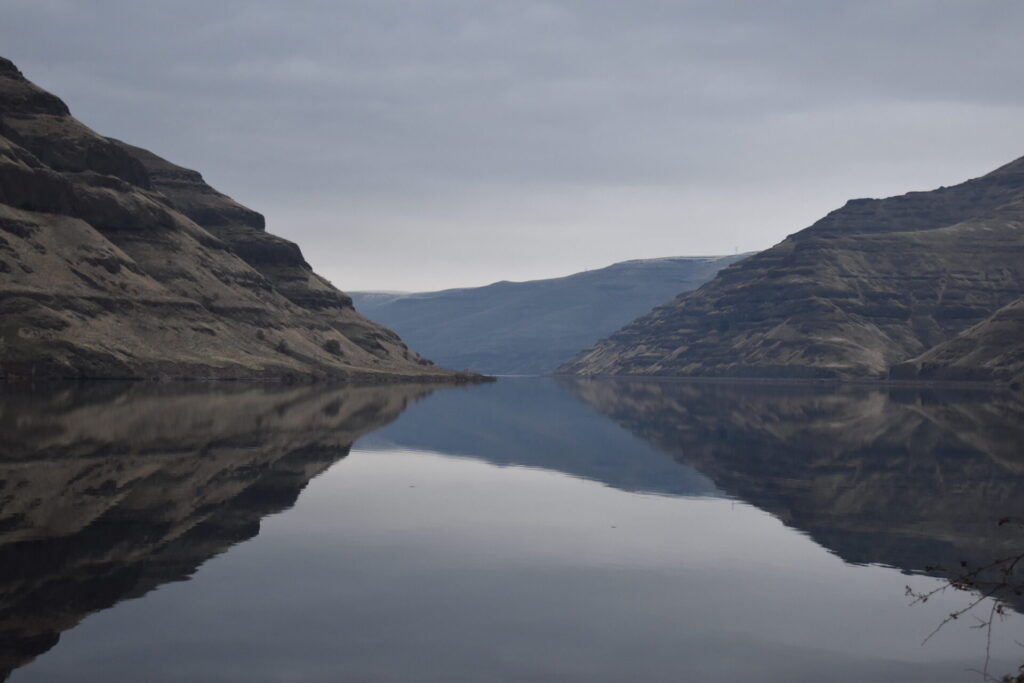
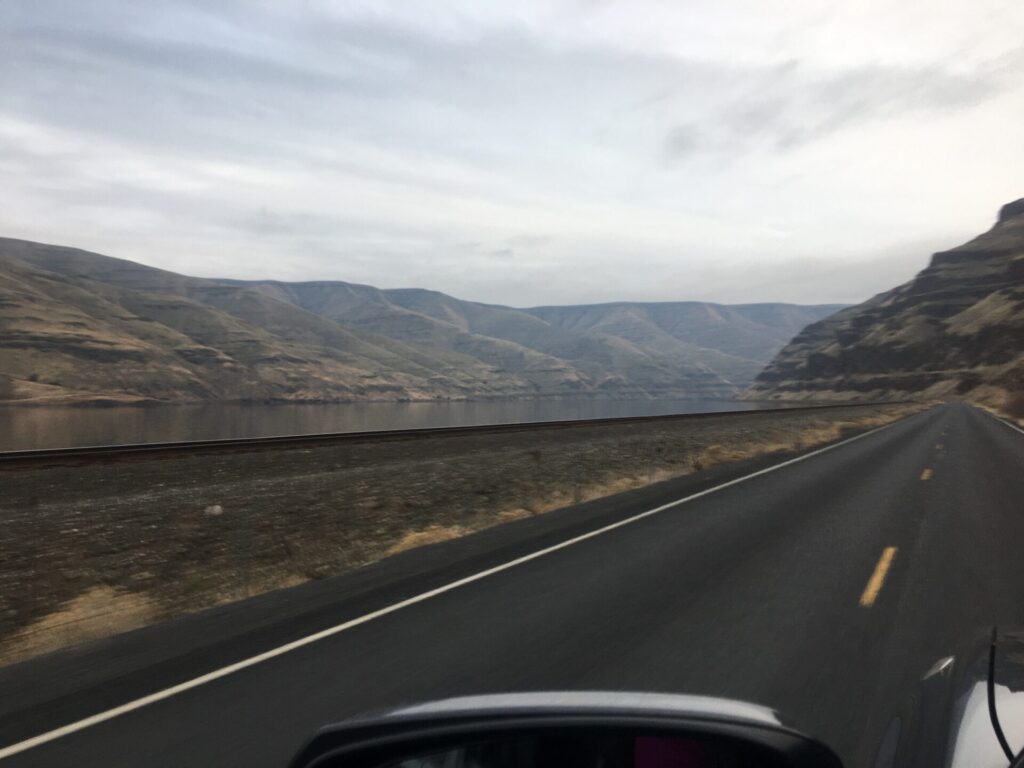
Part 2: the Wenatchee Guard Station, coming next!
Staying at the Clearwater Lookout Cabin.
The Clearwater Lookout cabin is available for rental year-round through recreation.gov. The lookout is closed to public access and the lower stairs have been removed. From June 1 – October 31, you can generally drive right up to the cabin, but those dates are dependant on snow and road conditions. In winter, access is limited to snowmobiles, skis, or snowshoes and requires a 6.5 mile trek from the Rose Spring Sno-Park south of Pomeroy. The journey can be longer in bad snow conditions.
The Pomeroy ranger station requires your reservation to be confirmed before they release the combination codes to the cabin, so you’ll need to call them after making your reservation or stop by the office for details.
Although the cabin is well stocked, I would still be very self-sufficient here, especially in winter. Bring what you need and don’t rely on cabin stock.
Amenities. The cabin is dog-friendly and comes with 4 mattresses, 2 of which are bunks. The lights, furnace, refrigerator, cookstove, and oven are all propane-powered. The kitchen is very well stocked with cookware, but much is old and well worn, so it is recommended to bring your own. The cabin has a nearby outdoor restroom facility and also an outdoor fire pit and picnic table.
Cabin supplies. During my stay the cabin was stocked with paper products, some matches, and flashlights, but I wouldn’t rely on these things. The matches were in very low supply so I was happy I had my own.
Water. There is no potable water at the cabin but in winter you can easily melt snow. During other months you should bring your own supply or obtain water from many of the surrounding numerous springs.
Tips. The propane lights are dim so consider bringing some extra lights. I always carry along my little solar Solights, which are lightweight and provide hours of light. I brought a warm sleeping bag and a sleeping pad that doubled as a pillow and extra padding.
As always, please be respectful of these amazing historic places, clean up after your pet and yourself, and leave them better than you found them so others can enjoy these special rentals for generations to come.
